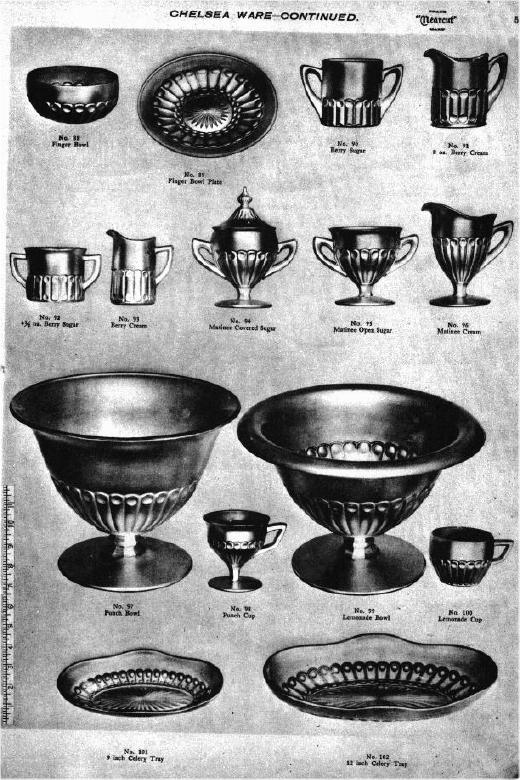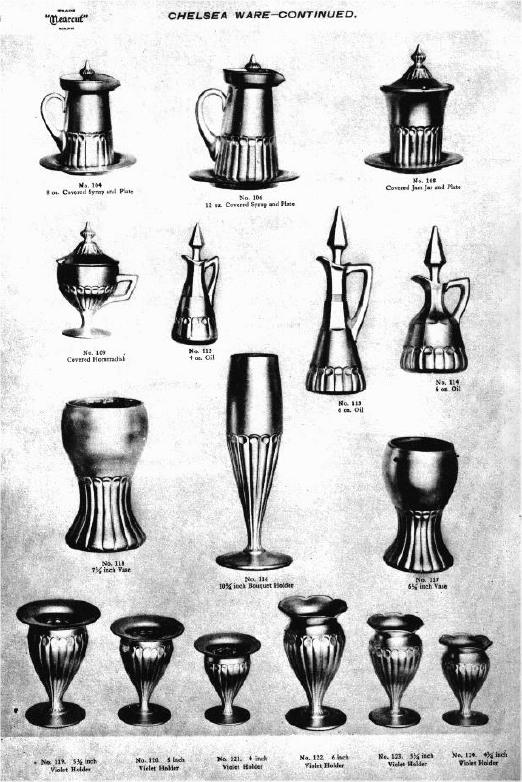Novelty Items, Part III - Chelsea Ware
by Mark A. Nye
Issue No. 229 - May 1992
The first reference to the Chelsea line is found in an advertisement first published in the December 6, 1920 issue of China, Glass and Lamps and repeated in the next five consecutive weekly issues. A similar advertisement ran in the December 13, 23, 30, 1920 issues of Crockery and Glass Journal. In addition to featuring Chelsea, both ads also extended Seasons Greetings and Best Wishes for 1921 and informed readers that Cambridge would be displaying at the Hotel Henry, Pittsburgh from January 12th to 29th.
Part of the text from the full page CGJ ad read: "See our complete display of this new line of Tableware and Novelties, also complete new Etched and Cut lines." Illustrating the advertisement were five pieces of Chelsea Ware: the #94 and #96 matinee covered sugar and cream; the #108 covered jam jar and plate; the #106 12 oz. covered syrup and plate; and the #47 8½" deep bowl.
The CGL ad was only a half page in size and, in part, read: "See our complete display of this new line of Tableware and Novelties. Also complete new Etched and Cut Lines." Shown in this instance was the Chelsea #147 3.25" sweetmeat and the #144 half-pound candy jar.
The January 17, 1921 issue of China, Glass and Lamps contained a full page Cambridge advertisement that feature the same five pieces of Chelsea first seen in the December CGJ advertisements and once again stated "See our complete display of this new line of Tableware and Novelties ..."
Chelsea Ware was featured on the first ten pages of the Cambridge Catalog No. 10, probably issued in late 1920 or perhaps at the 1921 Pittsburgh show. It is from those pages the illustrations for this article are taken.
A total of 145 Chelsea items were shown on these ten pages, of which 25 this author would say were not usual tableware items. (Included in this group were some perhaps debatable items, handled lemonade cups and punch bowls for example.) Would all 25 be considered novelties? Definitely not, especially the punch bowls and lemonade cups. On the other hand, would all of the 120 tableware items not be called novelties? In my opinion, the answer is once again, no.
Whether or not, the #71, #72 and #73 three-toed bowls are true novelties is open for debate. In view of the number of toed or footed bowls that came later, one would have to say that such items were not novelties. However, at the time the Chelsea line was issued, the items would have been somewhat unique and possibly novelties.
I would class the #80 and #81 celery dips or almonds as novelties for two reasons. Their intended purpose and their style. Again, one could argue individual celery dips or almonds were not that unusual during the period Chelsea was being made and that these pieces would not have been called novelties. However, the fact they are stemmed does make them somewhat unusual.
Rather unusual also is the two-handled #79 tall comport. What is different here are the handles, but do they make this piece a novelty, I really don't know. This same piece also appears, with a cover, as the #138 covered jam dish and again, is it a novelty?
I would think the stemmed matinee sugars and cream could be considered novelties. Stemmed sugars and creams are rather unusual in the Cambridge line, and based on their catalog description, they are intended for use solely during the afternoon functions, such as teas.
The matinee sugar minus one handle and with a notched lid was offered as the #109 covered horseradish. Today, this would definitely be a novel or unusual item; in 1921 specialty dishes or containers were not so uncommon, but still, this piece could probably be called a novelty.
Two other unique and novel items are the #136 and #137 celery baskets, made by adding handles to the #101 and #102 celery trays. Tableware, yes and to me these would also be classified as novelties.
Based on what was stated in the Chelsea advertisements, all of the Chelsea violet holders and other flower holders would have been considered novelties. This includes the #116 tall bouquet holder, the two flower baskets, the #126 and #127; and the two sweet pea vases, #173 and #174. In a strict sense, however, most vases would not be considered novelties.
As stated last month, "While there is no doubt about some items being novelties, it was, and is, often the eye of the beholder that determines if an item should be considered a novelty or not." This is especially true in lines such as Chelsea and Community.
No mention of Chelsea is found in trade journals after its 1921 debut. Plate etchings were becoming popular and 1922 saw the introduction of the opaque colors and this was what was, for the most part, featured in trade journal advertisements and news items.
No doubt Chelsea remained in production for several years. A few pieces are known in color. For example the #144 half-pound covered candy box is known in Topaz and the #61 4½" deep bowl in Cobalt Blue I with a frosted edge.
Chelsea Ware was not illustrated in the 1927 Cambridge catalog, hence it had been discontinued by that date.
To be continued ...


